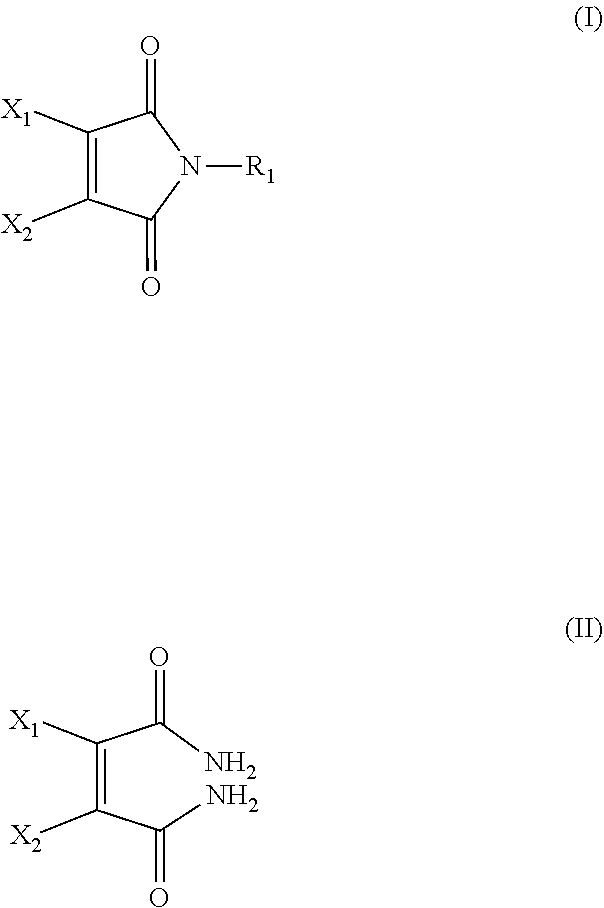Method of capturing and stabilising thiols
a thiol and stabilising technology, applied in the field of thiol stabilisation and capture, can solve the problems of inconvenient and problematic current methods for determining and analysing malodour, and achieve the effect of bright spectrum and capture and stabilising the malodour generated by human skin
- Summary
- Abstract
- Description
- Claims
- Application Information
AI Technical Summary
Benefits of technology
Problems solved by technology
Method used
Image
Examples
example 1
of Thiol-Capture Agent
[0064]Dibromomaleimide (DBM) can be synthesized according to the method disclosed in U.S. Pat. No. 4,680,272.
[0065]N-PEG dibromomaleimide (PEG-DBM) can be synthesized according to the following method. Step 1: obtaining N-methoxycarbonyl-3,4-dibromomaleimide. To a solution of 3,4-dibromomaleimide (1.00 g, 3.9 mmol) and N-methylmorpholine (0.43 mL, 3.90 mmol) in THF (50 mL), methylchloroformate (0.30 mL, 3.90 mmol) was added and the mixture was stirred for 20 minutes at room temperature. To this mixture, dichloromethane (DCM, 40 mL) was added and the organic phase was washed with water (3×100 mL), dried with MgSO4. The solvent was removed in vacuo to yield the titled product as a purple powder. 1H NMR (CDCl3, 300 MHz) δ (ppm): 4.01 (3H, s, COCH3). 13C NMR (CDCl3, 75 MHz) δ (ppm): 131.4 (C═C), 54.8 (COCH3). Step 2: N-methoxycarbonyl-3,4-dibromomaleimide (31 mg, 0.1 mmol) was dissolved in DCM (2 mL) and amino-PEG (2 kDa, 200 mg, 0.11 mmol) in DCM (2 mL) was added....
example 2
of the Hydrogel
[0066]PolyAMPS hydrogel samples were synthesised using the following method. A batch of reaction mixture was prepared from 2-acrylamido-2-methylpropane sulfonic acid sodium salt (NaAMPS, 50% by weight in water, 46.4 g in total), poly(ethylene glycol) diacrylate (PEGDA, Mn˜575 g mol−1, 0.1077 g), water (30.53 g) and the photo-initiator Irgacure 1173 (2-hydroxy-2-methylpropiophenone, 0.1 ml of a 10% aqueous solution). 3 ml samples were transferred to individual moulds and then photo-cured using high intensity UV radiation from a Light Hammer® from Fusion UV Systems Corp.
example 3
nd Stabilisation of Thiols by DBM
[0067]The reaction of 3-mercaptohexan-1-ol with DBM was noticeably quick, with the change in UV spectra recordable within 5 minutes. The reaction was carried out in methanol solvent.
[0068]FIG. 1 shows the UV spectra of the reaction of DBM (0.75 mg / mL) with 3-mercaptohexan-1-ol (500 μg / mL) after 5 minutes. The absorbance at A=305-312 nm is assigned to DBM with no substituted thiol. The DBM solution is colourless. Once substituted with the thiol, an absorbance at around A=370 nm is observed and the solution is yellow.
[0069]FIG. 2 shows the dynamic absorbance at 370 nm of the reaction of DBM with 3-mercaptohexan-1-ol. The absorbance at 370 nm indicates the presence of substituted DBM.
PUM
| Property | Measurement | Unit |
|---|---|---|
| concentrations | aaaaa | aaaaa |
| vapor pressure | aaaaa | aaaaa |
| vapor pressure | aaaaa | aaaaa |
Abstract
Description
Claims
Application Information
 Login to View More
Login to View More - R&D
- Intellectual Property
- Life Sciences
- Materials
- Tech Scout
- Unparalleled Data Quality
- Higher Quality Content
- 60% Fewer Hallucinations
Browse by: Latest US Patents, China's latest patents, Technical Efficacy Thesaurus, Application Domain, Technology Topic, Popular Technical Reports.
© 2025 PatSnap. All rights reserved.Legal|Privacy policy|Modern Slavery Act Transparency Statement|Sitemap|About US| Contact US: help@patsnap.com


